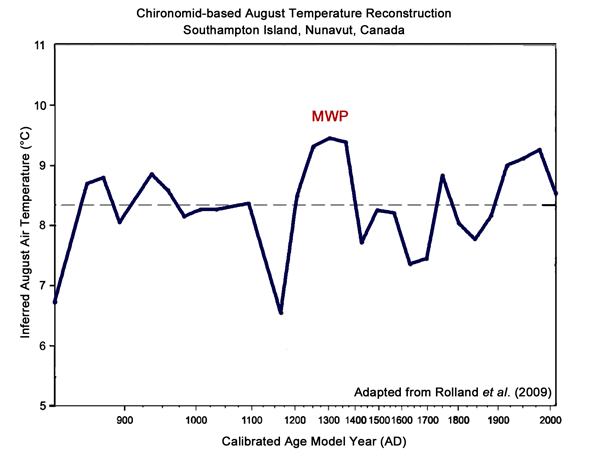Reference
Rolland, N., Larocque, I., Francus, P., Pienitz, R. and Laperriere, L. 2009. Evidence for a warmer period during the 12th and 13th centuries AD from chironomid assemblages in Southampton Island, Nunavut, Canada. Quaternary Research 72: 27-37.
What was done
Working in Nunavut, Canada, the authors reconstructed the late-Holocene evolution of a northern Southampton Island lake (Lake 4, unofficially known as Tasiq Qikitalik, located at 65°05'70'N, 83°47'49'W) by studying fossil chironomid distributions together with sedimentological data (X-ray fluorescence, grain size and C/N ratios) obtained from a sediment core retrieved from the lake's deepest reachable point by means of a gravity corer, deriving in the process a 1200-year history of inferred August temperatures.
What was learned
Rolland et al. report that (1) "higher temperatures were recorded from cal yr AD 1160 to AD 1360, which may correspond to the Medieval Warm Period," and that (2) "between cal yr AD 1360 and AD 1700, lower temperatures were probably related to a Little Ice Age event," the latter of which periods exhibited a minimum August temperature that was "ca. 2°C colder than the maximum observed during the Medieval Warm Period." Also of note, as can be seen from the figure below, the most recent August temperature (which occurs at the end of the record at about 2008) is approximately 0.9°C less than the maximum August temperature of the Medieval Warm Period.

Inferred August air temperature over Lake 4 of Nunavut, Canada's Southampton Island vs. time. Adapted from Rolland et al. (2009).
What it means
Once again -- to use a phrase we have employed over and over and over -- we have another example of the reality of the Medieval Warm Period and its thermal superiority (greater warmth) compared to that of the Current Warm Period, which even at its 1980 peak was still about 0.2°C cooler than the Medieval Warm Period was during its peak warmth, when the air's CO2 concentration was more than a hundred parts per million less than it is currently.




